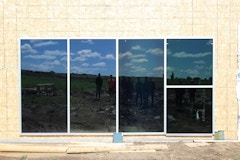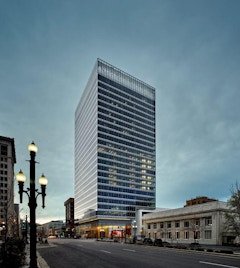
57 results
-
 Structural glass is used in a range of building applications, and while the ASTM E1300 has recently been updated to provide a design method to…
Structural glass is used in a range of building applications, and while the ASTM E1300 has recently been updated to provide a design method to… -

Glass and Electromagnetic Eavesdropping Protection
- Paper by Eric Stein,
Glass is a key component in building design. Benefits of utilizing Insulating Glass Units (IGUs) within a building facade are well understood,… -

Undulated Glass Self-shading
- Paper by Nebojsa Jakica, Assistant professor in Facade Design and Engineering Mikkel K. Kragh, Professor, Head of Civil and Architectural Unit
The research is structured around complex optical effects of undulated glass and coatings that exhibit high reflectivity, especially at higher… -

The Glass Failure Prediction Model
- Paper by James G. Soules, P.E., S.E., P.Eng., SECB, F. SEI, F. ASCE, Graduate Student, Department of Civil, Environmental, and Construction Engineering Stephen M. Morse, P.E., Ph.D., A.M, ASTM, Assistant Professor of Civil and Environmental Engineering H. Scott Norville, P.E., Ph.D., F. FTI, F. ASCE, F. ASTM, Professor, Department of Civil, Environmental, and Construction Engineering
ASTM E 1300 Standard Practice for Determining Load Resistance (LR) of Glass in Buildings defines the load resistance of a glass construction as being… -
Spandrel Glass Design
- Paper
Currently, most spandrel glass in commercial curtain walls comprises insulating glass fabricated using an interior heat strengthened glass lite that… -

Heat-Treated Glass
- Paper by Reece Poth · Conner Claus
What was once an accepted reality in heat-treated exterior glass, optical disturbances in glass are under increasing scrutiny by developers,
-

Fully Tempered Glass in Spandrel Applications
- Paper by Stéphane Hoffman, PE, Lawrence D. Carbary,
Recent years have seen an increase in the use of insulated glazing units (IGUs) in spandrel applications to visually blend the appearance between the… -

Innovations with Glass
- Paper by Jens Schneider, S. Müller-Braun, T. Peters, M. Schuster,
Glass has become a popular building material that is used not only for windows but also as a load-bearing material. New dimensions of glass panes in… -

Specifying Electrochromic Glass
- Paper by Belinda Valenti, AIA, LEED AP BD+C · Justin Glover, AIA, LEED AP BD+C
Electrochromic (EC) glass is a seemingly magical solution to a building’s sun shading problems. A technology that was originally developed about
-

Silicone Spandrel Glass Opacifiers
- Paper by Scott Norville · Samir Blanchet · George Torok · Kris Vockler · John Swanson · Chris Barry · Lawrence Carbary · Stephane Hoffman · Timothy Krytenberg · Chris Fronsoe
Curtain wall design commonly uses insulating glass units for vision and spandrel glazing to provide better visual harmonization of building facade
-
Let Thin Glass in the Facade Move
- Paper by Prof. DI Dr. Jürgen Neugebauer · DI Dr. Markus Wallner-Novak
Facades play an important role in the control of energy flow and energy consumption in buildings as they represent the interface between the outdoor
-
Kinematic Structural Glass
- Paper by Lisa Follman, AIA · Gregor Horstmeyer, PE
The structural glass storefront facade at 111 Main Street in Salt Lake City lends itself as a case study in accommodating large building
-
Designing Structural Laminated Glass
- Paper by Vaughn Schauss
Laminated glass with standard PVB has long been used for safety and security due to its ability to adhere the broken glass fragments together. As the
-

Realizing Bespoke Structural Glass Facades
- Paper by Ned Kirschbaum, FAIA, CCCA, LEED AP · Peter Koukos · Alfonso Lopez, P.E.
In the very earliest stages of a design, an architect imagines a unique glazed facade form and wonders, “Is this possible?” and “What will it cost?”
-

Anisotropic Effects in Architectural Glass
- Paper by Luis M. Hidalgo · Michael Elstner
Iridescence effects, quench marks, leopard marks… The names given to optical anisotropy in toughened and heat-strengthened glass are diverse and
-
Thermal Stress Analysis in Glass
- Paper by Michael Elstner, Director of Technical Advisory Service Michaela Poláková, TAS Engineer Steffen Schäfer,
The use of glass in windows and curtain walls in residential as well as in commercial buildings needs to be designed very carefully. In addition to… -
Corrugated-geometry Copper and Glass Facade
- Paper by Marko Tomsic, PE · John A. Jackson, AIA
The subject of this case study is the design and construction of a custom corrugated-geometry facade featuring pre-patinated copper and glass for an
-

Prototyping with Ultra-Thin Glass
- Paper by Sophie Pennetier · Josephine Stoddard · Karen Kensek
This paper proposes system concepts and fabrication methods for the use of ultra-thin glass in facades. It documents the team's research on
-

Seismic Design of Jumbo Glass Structures
- Paper by Alfonso E. Lopez, P.E. · David Dunham, P.E.
The design of structural glass systems continues to evolve with the parallel development of new manufacturing technology. Improvements in the
-

Feasibility of Measuring Stress in Glass with a SCALP
- Paper by Nabhajit Goswami · Stephen M Morse, P.E., Ph.D.
The SCALP device is designed to measure the residual compressive surface stress of glass. As the SCALP does not rely on the birefringence properties






